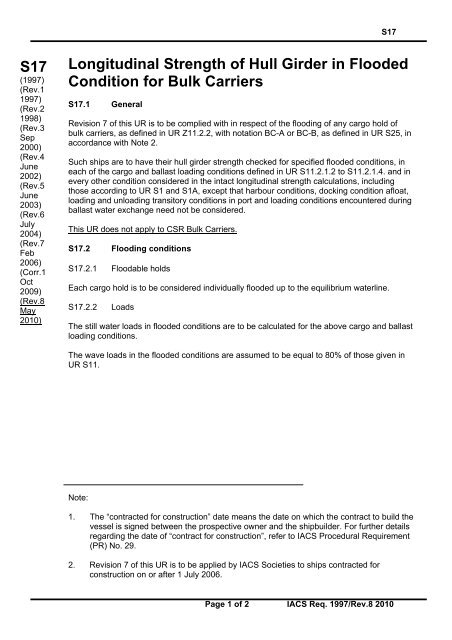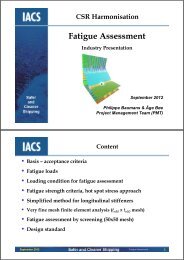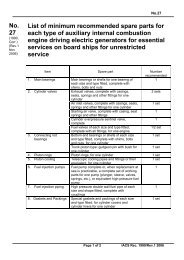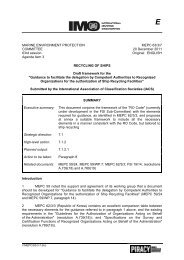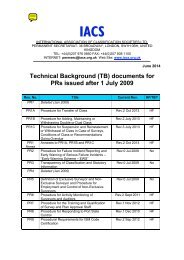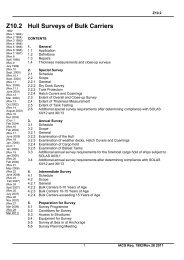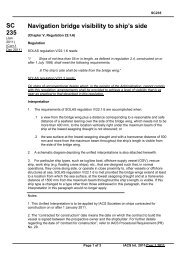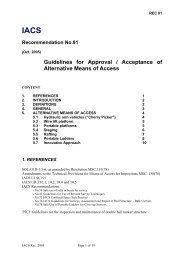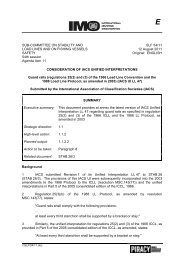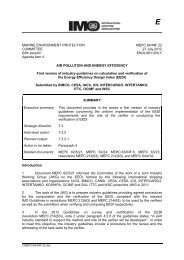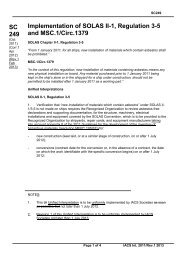S17 Longitudinal Strength of Hull Girder in Flooded ... - IACS
S17 Longitudinal Strength of Hull Girder in Flooded ... - IACS
S17 Longitudinal Strength of Hull Girder in Flooded ... - IACS
You also want an ePaper? Increase the reach of your titles
YUMPU automatically turns print PDFs into web optimized ePapers that Google loves.
<strong>S17</strong><br />
<strong>S17</strong><br />
(1997) (cont)<br />
(Rev.1<br />
1997)<br />
(Rev.2<br />
1998)<br />
(Rev.3<br />
Sep<br />
2000)<br />
(Rev.4<br />
June<br />
2002)<br />
(Rev.5<br />
June<br />
2003)<br />
(Rev.6<br />
July<br />
2004)<br />
(Rev.7<br />
Feb<br />
2006)<br />
(Corr.1<br />
Oct<br />
2009)<br />
(Rev.8<br />
May<br />
2010)<br />
<strong>Longitud<strong>in</strong>al</strong> <strong>Strength</strong> <strong>of</strong> <strong>Hull</strong> <strong>Girder</strong> <strong>in</strong> <strong>Flooded</strong><br />
Condition for Bulk Carriers<br />
<strong>S17</strong>.1 General<br />
Revision 7 <strong>of</strong> this UR is to be complied with <strong>in</strong> respect <strong>of</strong> the flood<strong>in</strong>g <strong>of</strong> any cargo hold <strong>of</strong><br />
bulk carriers, as def<strong>in</strong>ed <strong>in</strong> UR Z11.2.2, with notation BC-A or BC-B, as def<strong>in</strong>ed <strong>in</strong> UR S25, <strong>in</strong><br />
accordance with Note 2.<br />
Such ships are to have their hull girder strength checked for specified flooded conditions, <strong>in</strong><br />
each <strong>of</strong> the cargo and ballast load<strong>in</strong>g conditions def<strong>in</strong>ed <strong>in</strong> UR S11.2.1.2 to S11.2.1.4. and <strong>in</strong><br />
every other condition considered <strong>in</strong> the <strong>in</strong>tact longitud<strong>in</strong>al strength calculations, <strong>in</strong>clud<strong>in</strong>g<br />
those accord<strong>in</strong>g to UR S1 and S1A, except that harbour conditions, dock<strong>in</strong>g condition afloat,<br />
load<strong>in</strong>g and unload<strong>in</strong>g transitory conditions <strong>in</strong> port and load<strong>in</strong>g conditions encountered dur<strong>in</strong>g<br />
ballast water exchange need not be considered.<br />
This UR does not apply to CSR Bulk Carriers.<br />
<strong>S17</strong>.2 Flood<strong>in</strong>g conditions<br />
<strong>S17</strong>.2.1<br />
Floodable holds<br />
Each cargo hold is to be considered <strong>in</strong>dividually flooded up to the equilibrium waterl<strong>in</strong>e.<br />
<strong>S17</strong>.2.2<br />
Loads<br />
The still water loads <strong>in</strong> flooded conditions are to be calculated for the above cargo and ballast<br />
load<strong>in</strong>g conditions.<br />
The wave loads <strong>in</strong> the flooded conditions are assumed to be equal to 80% <strong>of</strong> those given <strong>in</strong><br />
UR S11.<br />
Note:<br />
1. The “contracted for construction” date means the date on which the contract to build the<br />
vessel is signed between the prospective owner and the shipbuilder. For further details<br />
regard<strong>in</strong>g the date <strong>of</strong> “contract for construction”, refer to <strong>IACS</strong> Procedural Requirement<br />
(PR) No. 29.<br />
2. Revision 7 <strong>of</strong> this UR is to be applied by <strong>IACS</strong> Societies to ships contracted for<br />
construction on or after 1 July 2006.<br />
Page 1 <strong>of</strong> 2 <strong>IACS</strong> Req. 1997/Rev.8 2010
<strong>S17</strong><br />
<strong>S17</strong><br />
(cont)<br />
<strong>S17</strong>.3 Flood<strong>in</strong>g criteria<br />
To calculate the weight <strong>of</strong> <strong>in</strong>gressed water, the follow<strong>in</strong>g assumptions are to be made:<br />
a) The permeability <strong>of</strong> empty cargo spaces and volume left <strong>in</strong> loaded cargo spaces above<br />
any cargo is to be taken as 0.95.<br />
b) Appropriate permeabilities and bulk densities are to be used for any cargo carried. For<br />
iron ore, a m<strong>in</strong>imum permeability <strong>of</strong> 0.3 with a correspond<strong>in</strong>g bulk density <strong>of</strong> 3.0 t/m 3 is<br />
to be used. For cement, a m<strong>in</strong>imum permeability <strong>of</strong> 0.3 with a correspond<strong>in</strong>g bulk<br />
density <strong>of</strong> 1.3 t/m 3 is to be used. In this respect, "permeability" for solid bulk cargo<br />
means the ratio <strong>of</strong> the floodable volume between the particles, granules or any larger<br />
pieces <strong>of</strong> the cargo, to the gross volume <strong>of</strong> the bulk cargo.<br />
For packed cargo conditions (such as steel mill products), the actual density <strong>of</strong> the cargo<br />
should be used with a permeability <strong>of</strong> zero.<br />
<strong>S17</strong>.4 Stress assessment<br />
The actual hull girder bend<strong>in</strong>g stress σ fld , <strong>in</strong> N/mm 2 , at any location is given by:<br />
<br />
fld<br />
M<br />
<br />
sf<br />
0.8M<br />
W<br />
Z<br />
W<br />
10<br />
3<br />
where:<br />
M sf = still water bend<strong>in</strong>g moment, <strong>in</strong> kNm, <strong>in</strong> the flooded conditions for the section under<br />
consideration<br />
M W = wave bend<strong>in</strong>g moment, <strong>in</strong> kNm, as given <strong>in</strong> UR S11.2.2.1 for the section under<br />
consideration<br />
W Z = section modulus, <strong>in</strong> cm 3 , for the correspond<strong>in</strong>g location <strong>in</strong> the hull girder.<br />
The shear strength <strong>of</strong> the side shell and the <strong>in</strong>ner hull (longitud<strong>in</strong>al bulkhead) if any, at any<br />
location <strong>of</strong> the ship, is to be checked accord<strong>in</strong>g to the requirements specified <strong>in</strong> UR S11.4 <strong>in</strong><br />
which F S and F W are to be replaced respectively by F SF and F WF , where:<br />
F SF = still water shear force, <strong>in</strong> kN, <strong>in</strong> the flooded conditions for the section under<br />
consideration<br />
F WF = 0.8 F W<br />
F W = wave shear force, <strong>in</strong> kN, as given <strong>in</strong> UR S11.2.2.2 for the section under consideration<br />
<strong>S17</strong>.5 <strong>Strength</strong> criteria<br />
The damaged structure is assumed to rema<strong>in</strong> fully effective <strong>in</strong> resist<strong>in</strong>g the applied load<strong>in</strong>g.<br />
Permissible stress and axial stress buckl<strong>in</strong>g strength are to be <strong>in</strong> accordance with UR S11.<br />
End <strong>of</strong><br />
Document<br />
Page 2 <strong>of</strong> 2 <strong>IACS</strong> Req. 1997/Rev.8 2010


